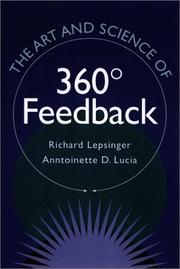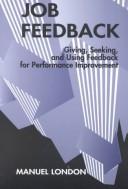| Listing 1 - 10 of 17 | << page >> |
Sort by
|
Book
Year: 1969 Publisher: Harmondsworth : Penguin,
Abstract | Keywords | Export | Availability | Bookmark
 Loading...
Loading...Choose an application
- Reference Manager
- EndNote
- RefWorks (Direct export to RefWorks)
Book
ISBN: 9782760546592 Year: 2017 Publisher: Québec : PRESSES DE L'UNIVERSITÉ DU QUÉBEC (PUQ),
Abstract | Keywords | Export | Availability | Bookmark
 Loading...
Loading...Choose an application
- Reference Manager
- EndNote
- RefWorks (Direct export to RefWorks)
L'utilisation régulière de la rétroaction et du débriefing dans les pratiques de formation souligne une nouvelle orientation pédagogique et didactique. Pour en comprendre le sens et la contribution dans la professionnalisation et le développement professionnel, cet ouvrage analyse leur place dans le triptyque
Communication in education --- Reflective learning --- Feedback (Psychology) --- Psychological debriefing

ISBN: 078790855X Year: 1997 Publisher: San Francisco, Calif. : Pfeiffer,
Abstract | Keywords | Export | Availability | Bookmark
 Loading...
Loading...Choose an application
- Reference Manager
- EndNote
- RefWorks (Direct export to RefWorks)
Organization theory --- Mass communications --- Feedback (Psychology) --- Organizational effectiveness --- Rétroaction (Psychologie) --- Efficacité organisationnelle --- Organizational effectiveness. --- Feedback (Psychology). --- communicatie, intern --- human resources management --- organisatieleer --- psychologie, bedrijven --- bedrijfsvoering, effectiviteit --- performance measurement --- Rétroaction (Psychologie) --- Efficacité organisationnelle

ISBN: 080582474X 0805824758 Year: 1997 Publisher: Mahwah, N.J. : Lawrence Erlbaum Associates,
Abstract | Keywords | Export | Availability | Bookmark
 Loading...
Loading...Choose an application
- Reference Manager
- EndNote
- RefWorks (Direct export to RefWorks)
Employee motivation --- Feedback (Psychology) --- Performance standards --- Personnel --- Rétroaction (Psychologie) --- Rendement au travail --- Motivation --- Normes --- Employee motivation. --- Performance standards. --- Arbeids- en organisatiepsychologie --- menselijke betrekkingen --- Feedback (Psychology). --- menselijke betrekkingen. --- Menselijke betrekkingen. --- Rétroaction (Psychologie)
Book
Year: 1980 Publisher: Louvain-la-Neuve : Université catholique de Louvain, Institut des sciences politiques et sociales,
Abstract | Keywords | Export | Availability | Bookmark
 Loading...
Loading...Choose an application
- Reference Manager
- EndNote
- RefWorks (Direct export to RefWorks)
Book
ISBN: 276400723X Year: 2003 Publisher: Outremont (Québec, Canada) : Québécor,
Abstract | Keywords | Export | Availability | Bookmark
 Loading...
Loading...Choose an application
- Reference Manager
- EndNote
- RefWorks (Direct export to RefWorks)
Learning --- Constructivism (Education) --- Feedback (Psychology) --- Competency-based education --- Apprentissage --- Constructivisme (Education) --- Rétroaction (Psychologie) --- Education basée sur la compétence --- Evaluation --- Rétroaction (Psychologie) --- Education basée sur la compétence
Multi
ISBN: 9789811961762 9789811961755 9789811961779 Year: 2022 Publisher: Singapore : Springer,
Abstract | Keywords | Export | Availability | Bookmark
 Loading...
Loading...Choose an application
- Reference Manager
- EndNote
- RefWorks (Direct export to RefWorks)
The phase-locking of multiple spin-torque nano oscillators(STNOs) is considered the primary vehicle to achieve sufficient signal quality for applications. This book highlights the resonator's design and its need for feedback for phase locking of STNOs. STNOs can act as sources of tunable microwaves after being phase-locked together. External feedback from a coplanar waveguide placed above an STNO helps ensures coherent single domain oscillations. STNOs placed within magnonic crystal cavities also demonstrate coherent oscillations. Arrays of such cavities provide a route to scale power levels from such nano-oscillators. The book presents numerical and micromagnetics to validate the design. .
Mathematical physics --- Electromagnetism. Ferromagnetism --- Physics --- Spectrometric and optical chemical analysis --- Telecommunication technology --- Applied physical engineering --- toegepaste wetenschappen --- theoretische fysica --- tekstverwerking --- wiskunde --- ingenieurswetenschappen --- fysica --- magnetisme --- spectrometrie --- Cavity resonators. --- Feedback (Psychology)

ISBN: 1882197585 9781882197583 1118127455 9786611001148 1118127463 1281001147 1932973052 9781932973051 Year: 2000 Publisher: Greensboro, N.C. : Center for Creative Leadership,
Abstract | Keywords | Export | Availability | Bookmark
 Loading...
Loading...Choose an application
- Reference Manager
- EndNote
- RefWorks (Direct export to RefWorks)
Whatever level you occupy in an organization, from line manager to senior executive to team leader, the skill of giving meaningful and effective feedback is an important component to helping other people develop and to getting the job done. Creating and delivering a specific message based on observed performance is key to effective feedback. Your feedback should enable the receiver to walk away understanding exactly what he or she did and what impact it had on you. When the result is this specific and this direct, there is a better chance that the person getting the feedback will be motivated
Personnel Management. --- Feedback, Psychological. --- Communication in management --- Personnel management --- Supervision of employees. --- Communication en gestion --- Personnel --- Supervision des employés --- Handbooks, manuals, etc. --- Guides, manuels, etc. --- Direction --- Guides, manuels, etc --- Feedback (Psychology) --- Supervision des employés --- Learning, Psychology of --- Reinforcement (Psychology) --- Employees --- Supervision of employees --- Personnel Management --- Feedback, Psychological --- E-books
Book
ISBN: 1789842581 1789842573 1838816046 Year: 2018 Publisher: IntechOpen
Abstract | Keywords | Export | Availability | Bookmark
 Loading...
Loading...Choose an application
- Reference Manager
- EndNote
- RefWorks (Direct export to RefWorks)
The six chapters in this volume form a timely introduction to biofeedback research. The six authors describe how objective electrophysiological data provides useful data for assessment and therapy for physical therapists, psychologists and other healthcare professionals and their clients. The first chapter, ""Biofeedback and neurofeedback in the treatment of migraine"", is written by Ph.D. student Zivoder Ivana. The second chapter by Prof. Dumitrascu looks at pelvic floor rehabilitation and is titled ""Factors predicting failure in anorectal biofeedback"". The third chapter by Dr Liao Da-Vin is titled ""Collaborative, social-networked posture training with posturing monitoring and biofeedback"". It is a useful and timely description of the role of biofeedback to support rehabilitation therapy at home and describe how objective information of physiotherapy treatments could increase the quality of service and the consistency of treatment outcomes. The fourth chapter by Prof. Silva Hugo is titled ""Bridging the clinic-home divide in muscular rehabilitation"". It also covers the role of biofeedback to support rehabilitation therapy at home. The fifth chapter is written by Ph.D. student Grin-Yatsenko Vera and is titled ""Effect of infra-low frequency neurofeedback on infra-slow-EEG-fluctuations"". The sixth and final chapter in the volume, ""Control systems of bionic limbs of the new generation and control systems with EMG signals of VR and games, toys"" by M.A. Ivaniuk Natallia goes beyond the person and shows how biofeedback can be integrated in the behavior of a bionic hand.
Biological control systems. --- Biofeedback training. --- Visceral learning --- Biological control systems --- Feedback (Psychology) --- Mind and body --- Operant conditioning --- Psychotherapy --- Biocybernetics --- Biofeedback --- Biological cybernetics --- Biological regulation --- Control biophysics --- Control systems, Biological --- Control theory in biology --- Regulation, Biological --- Biological systems --- Control theory --- Cybernetics --- Feedback control systems --- Nervous system --- Medicine --- Biomedicine --- Health Sciences
Book
ISBN: 3030639940 3030639932 Year: 2020 Publisher: Cham, Switzerland : Springer,
Abstract | Keywords | Export | Availability | Bookmark
 Loading...
Loading...Choose an application
- Reference Manager
- EndNote
- RefWorks (Direct export to RefWorks)
The book provides new insights into written corrective feedback by describing students’ expectations as well as mediating factors that influence their engagement with it. The book draws on an extensive dataset to illustrate secondary school students’ behavioural, cognitive and emotional engagement with written corrective feedback and the extent to which mediating factors, such as teachers, peers, feedback options, attitudes and emotions, foster or hinder it. It shows why teachers need to provide students with the purpose of the corrective feedback they provide, explain how such feedback works and introduce strategies that can be employed to engage with it. Based on the finding that a combination of several feedback types is essential to ensure learner engagement, the book also provides an extensive description and multiple authentic examples of the Engagement-Feedback-Mediator Model that was developed in the context of this study.
Linguistics. --- Language and education. --- Linguistics, general. --- Language Education. --- Educational linguistics --- Education --- Language and languages --- Linguistic science --- Science of language --- Feedback (Psychology) --- Grading and marking (Students) --- Graded schools --- Marking (Students) --- Students --- Educational tests and measurements --- Examinations --- School reports --- Learning, Psychology of --- Reinforcement (Psychology) --- Grading and marking --- Interpretation --- Rating of
| Listing 1 - 10 of 17 | << page >> |
Sort by
|

 Search
Search Feedback
Feedback About
About Help
Help News
News